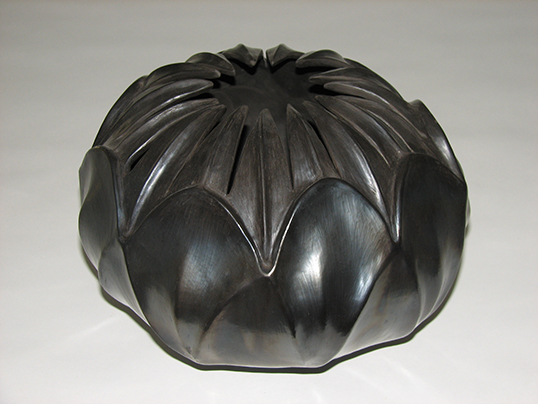
Laura Wee Láy Láq’s work is handbuilt, burnished and finished without glaze.| Photo courtesy of Laura Wee Láy Láq.
Laura Wee Láy Láq, an accomplished potter and ceramic artist, will be presenting at the Surrey Art Gallery as part of the Thursday Artist Talk series (Mar. 3) where she will share her unique technique and love for working with clay.
With roots in the Stó:lō Nation, Wee Láy Láq’s art is steeped in tradition and a deep understanding of her craft and heritage. Using rare handbuilding and burnishing techniques, her pieces reflect the beginnings of the art form itself, and her passion for it.
“One of the things I’m known for is that my work is hard to categorize. Since it’s all hand-built, it’s pinched and pulled, and really takes on a life of its own,” says Wee Láy Láq.
The artistry of handbuilding
Wee Láy Láq’s ceramic career began at a young age and her affinity for working with clay began in high school.
She went on to further her studies of the craft at the Vancouver School of Art – now known as the Emily Carr University of Art and Design – and graduated with honours in 1977.
“I have been doing pottery and working with clay for 45 years. I set it aside for a time to focus on learning my father’s ancestral language, and spent 18 years doing that,” says Wee Láy Láq. “I was also exhibiting and making pottery, but now I am back in the studio full-time, which I am so thrilled about.”
Her work reflects a mastery of the hand-built technique: working the clay into a range of shapes and styles with her fingertips.
“One of the beautiful things about handbuilding is that it’s very relaxing. You are shaping it at your own pace rather than on a wheel, which can be very demanding in that you need to keep up with the speed, and it can have a production line feel at times,” says Wee Láy Láq.
Wee Láy Láq’s work is also unique in that it is burnished, fired in sawdust, and finished without glaze.
“My work is ultra-thin which, as experienced potters know, is difficult to maintain. There are also very few people who ‘burnish.’ Burnishing is about the surface quality – finishing the piece by rubbing it with a smooth stone, rather than using a glaze,” says Wee Láy Láq .
Wee Láy Láq fires her pieces in a mixture of sawdust which smokes over two days. This process along with the type of clay used determines the unique final appearance of her pieces.
Language, culture and nature as inspiration
Wee Láy Láq grew up in Burnaby, but identifies closely with the heritage of her parents’ ancestral Nations.
“My father is from the Ts’elxweyeqw [Chilliwack] Tribe, which is a member of the Sto:lo Nation, and my mother’s roots stem from the Oweekeno and Wei Wai Kum [Cambell River] Tribes,” she says.
Throughout her ceramic career, Wee Láy Láq spent a number of years teaching her ancestral language Hel-ka-malem, at the University of the Fraser Valley.
“Diving into the language has given me more insight into my ancestral roots and culture. There is a real connection between language, culture, and the creative process you experience as an artist,” says Wee Láy Láq.
Her preferred technique of handbuilding with clay has evolved from both her experience with and study of the origins of pottery.
“As I grew older, I started to look at the indigenous people’s way of making pottery. The Peruvian, African and Incan potters have an incredible history of art. Their traditional way of making pottery is all handbuilding. That really inspired me to continue on this path,” says Wee Láy Láq .
With her work appearing sculptural in nature, inspiration for new designs is drawn from many sources. According to Wee Láy Láq, the shape of the final product usually arises organically.
“I get a lot of inspiration from walking outside. I’ll go to places that inspire me like gardens, and tap into the vision of the shapes that I see in nature. Using the handbuilding method, I can pull and sculpt the clay to get these very pod-like shapes, or petals, or the very protruding shapes that I’ve become known for,” says Wee Láy Láq.
As a result of the mastery of her craft and commitment to sustaining the artistic traditions of her ancestry, Wee Láy Láq was nominated for and awarded the BC Creative Achievement Award for First Nation Art in 2015.
A large selection of her work can be seen at the Museum of Anthropology at UBC.
To learn more about the Artist Talk series and the Mar. 3 event, visit www.surrey.ca (Culture and Recreation section).









